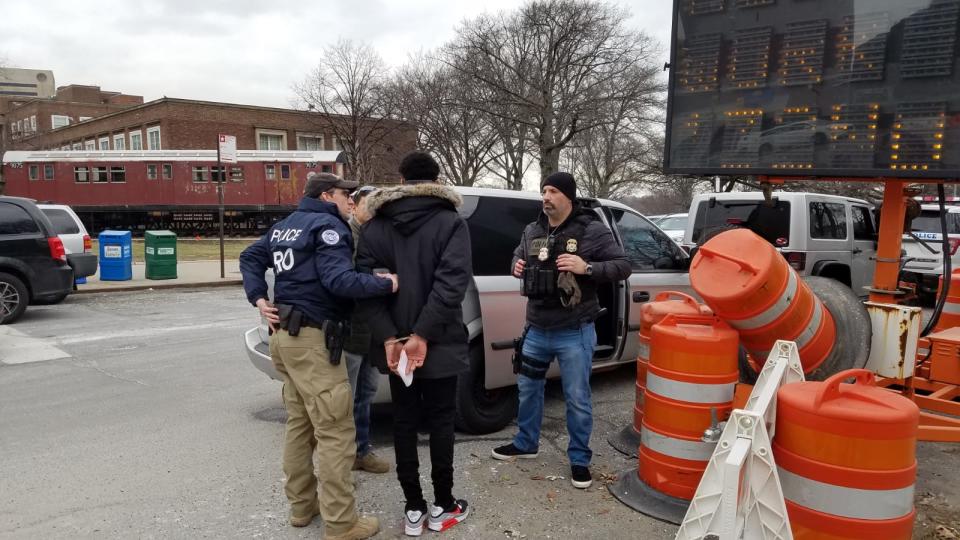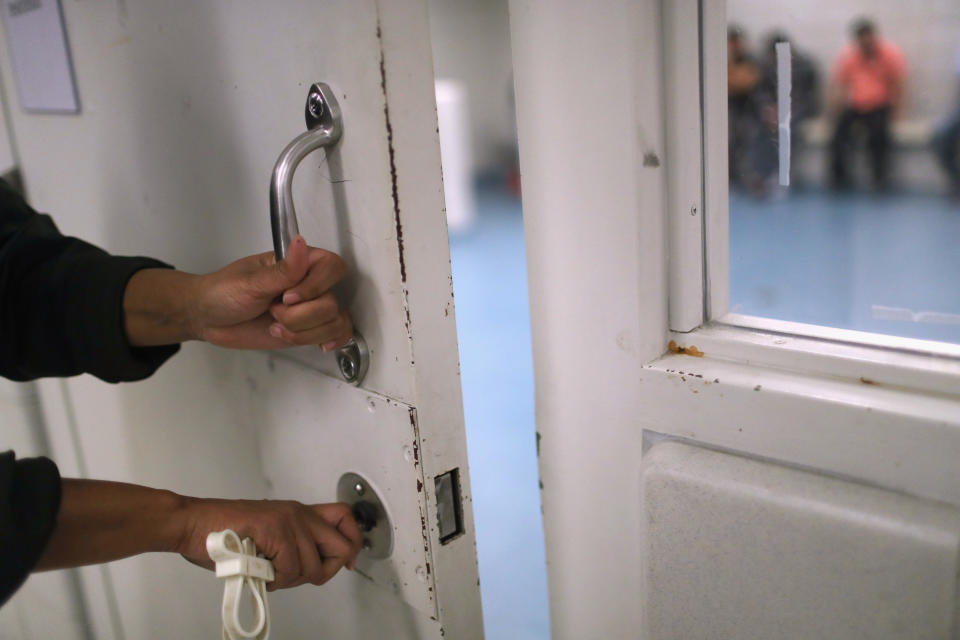Report details ICE targeting immigrants at the one place they have to appear: The courthouse

In apparent violation of ICE policy, federal immigration agents have been aggressively targeting immigrants at courthouses in New York state, tackling people to the ground, shoving family members against walls and pulling guns in front of children, according to a new report from an immigration rights group.
According to the report released Monday by the New York-based Immigrant Defense Project, U.S. Immigration and Customs Enforcement operations at courthouses across New York state rose 17 percent in 2018 over the previous year. Under the previous administration, they were almost unheard of. Not only has ICE continued to expand on this Trump-era trend but, according to the report, immigration agents in New York have begun using their access to courts to conduct increasingly intrusive surveillance of both immigrants and their attorneys, regularly disguising themselves in civilian clothes and refusing to identify themselves even while making arrests.
“ICE is just acting with impunity in the middle of state courts,” said Lee Wang, senior staff attorney at the Immigrant Defense Project (IDP), a nonprofit that focuses on the intersection between immigration enforcement and the criminal justice system. “Their behavior is so alarming that witnesses have reported to 911 that they thought they were witnessing a kidnapping.”
IDP has seen reports of ICE arrests at courthouses in New York skyrocket since shortly after President Trump was inaugurated. According to a report published by the organization on Dec. 31, 2017, reports of arrests or attempted arrests by ICE at courthouses across New York went from a total of 11 in 2016 to 144 in 2017, signifying what IDP called “a new era in aggressive ICE enforcement emboldened under the Trump administration.”
Court appearances, for anything from civil suits to felony arrests, are mandatory and a matter of public record, making them an easy target for immigration officers.
For the first time ever, on Jan. 10 of last year, ICE issued a formal policy directive with regard to civil enforcement operations at courthouses, a move that seemed to clearly target immigrants in cities and states with so-called sanctuary policies.
“Courthouse arrests are often necessitated by the unwillingness of jurisdictions to cooperate with ICE in the transfer of custody of aliens from their prisons and jails,” read the January 2018 memo issued by ICE’s then-deputy director Thomas Homan. The memo urged officers to avoid enforcement actions at family court, small claims court and other courthouses dedicated to noncriminal proceedings and described ICE’s courthouse enforcement actions as targeting specific “aliens with criminal convictions, gang members, national security or public safety threats, aliens who have been ordered removed from the United States but have failed to depart, and aliens who have re-entered the country illegally after being removed.” It stipulated that others encountered during such operations, such as witnesses or friends and family members accompanying the “target alien” should generally not be subject to arrest.
But IDP’s report says ICE agents aren’t abiding by that guidance and “appeared to ignore their own policy directive, continuing to conduct arrests in civil and criminal courts, and targeting friends and family members who accompanied a loved one to court.”
Despite ICE’s stated focus on specific targets, IDP notes that, in the last year, it has received “several reports of ICE agents questioning friends and family members who accompany their loved ones to court” in New York, leading to the arrests of family members in at least a few cases. In one example described in the report, a young man accompanying his brother to criminal court in Queens was arrested by plainclothes ICE agents — along with his brother — as they left the courthouse.
IDP also documented at least one case in which a father was approached by ICE agents inside a family courthouse in Westchester where he’d been waiting to appear in a case and, before he had a chance to talk to his attorney or the family court judge, was arrested and placed into removal proceedings. According to the report, Westchester County saw the biggest increase in courthouse arrests statewide over the past year. The largest number of such actions were in Brooklyn and Queens.

The report also accuses ICE of aggressively targeting vulnerable immigrants, pointing to arrests of young people eligible for DACA or other immigration benefits, as well as victims of domestic violence and human trafficking survivors.
“The most appalling effects of ICE’s practice is that we’re seeing survivors of violence who are afraid to go to court for protection orders [or] parents afraid to go to court to seek child support for their children,” said Lee.
According to an ICE spokeswoman, “ICE doesn’t track arrests made at courthouses.” Asked for a comment in response to the claims made in this latest report, the spokeswoman directed Yahoo News to ICE’s courthouse policy directive from January 2018 which, she noted, “was not a new policy but rather codification of existing policy.”
Although the report was confined to ICE operations at courthouses in New York, attorneys, advocates and law enforcement professionals say the incidents it describes are part of a national trend.
“The findings in IDP’s new report are troubling, but not at all surprising,” said Ruthie Epstein, senior policy analyst at the American Civil Liberties Union, in an email to Yahoo News. “We know that ICE has ramped up enforcement in courthouses across the country over the past two years — from New Hampshire and New York to Texas to Oregon and California — and often with the active cooperation of courthouse employees.”
“The justice system should be accessible to everyone, regardless of immigration status,” Epstein continued. “When ICE is prowling the hallways, getting information from court officers, and making arrests inside courthouses, immigrants will understandably feel apprehensive about coming to court — whether they’re a victim or survivor, a witness to a crime, a parent asserting custody rights, or a person paying a traffic ticket.”

Last month, 68 former state and federal judges from around the country echoed similar concerns in a letter to acting ICE Director Ronald Vitiello. The judges warned that “interrupting criminal proceedings with civil immigration arrests undermines the justice system.” They urged Vitiello to add courthouses to ICE’s list of “sensitive locations,” designated spaces such as schools, hospitals and places of worship, where agents are prohibited from conducting enforcement activities except in “exigent circumstances” involving threats of violence or national security risks.
“ICE’s reliance on immigration arrests in courthouses instills fear in clients and deters them from seeking justice in a court building,” the judges wrote, pointing to recent data that shows a disproportionate decrease in orders for protection sought by Latino residents in cities in California and a href=”https://www.nytimes.com/2018/06/03/us/immigrants-houston-domestic-violence.html”>Texas, as well as accounts from district attorneys in Brooklyn and Denver, where witnesses’ fears of deportation have forced prosecutors to drop or reduce charges in domestic violence and sexual abuse cases. “Across the country, this fear has meant valid law enforcement prosecutions are abandoned, or never pursued.”
“This is not a left-right issue,” said Lee, noting that the judges who signed this letter were representative of a range of ideologies. “People are starting to realize this is a basic access-to-justice issue.”
In New York City, ICE’s pursuit of courthouse arrests has sparked opposition from public defenders and district attorneys, including Cy Vance of Manhattan and Darcel Clark of the Bronx.
“It does not keep us safe,” Brooklyn District Attorney Eric Gonzalez said of ICE’s increased presence in New York courthouses last year. “It jeopardizes public safety.”
This month, New York state Assemblywoman Michaelle Solages and state Sen. Brad Hoylman introduced the Protect Our Courts Act, which would restrict ICE from carrying out civil immigration actions against people who show up for court in New York.
“The surge in ICE activity in and around our courthouses is deeply concerning,” Hoylman said in a statement to Yahoo News on Monday, responding to the findings in IDP’s latest report. “The basic functioning of our justice system depends on the participation of all New Yorkers, regardless of their immigration status — and we are all safer for it.”
IDP’s Wang called the proposed legislation “groundbreaking,” noting that in 2017 New York became the first state in the country to offer public defender services to immigrants in deportation proceedings.
Now, she said, New York has the opportunity to be the first again, by banning ICE from entering state courts without a judicial warrant.
“It would be a way for New York state to make good on its promise of being a sanctuary state for immigrants,” she said.
Read more from Yahoo News:



